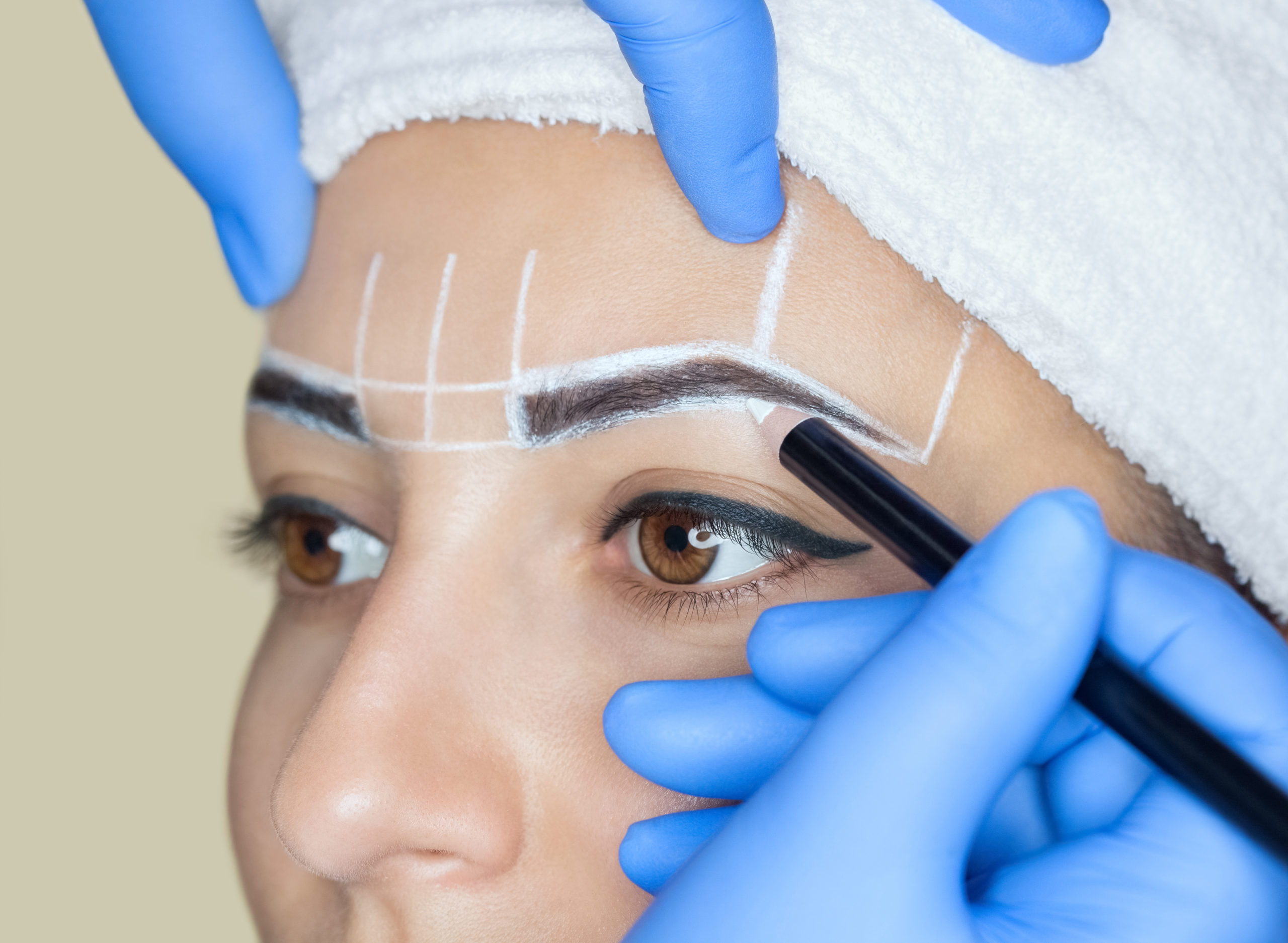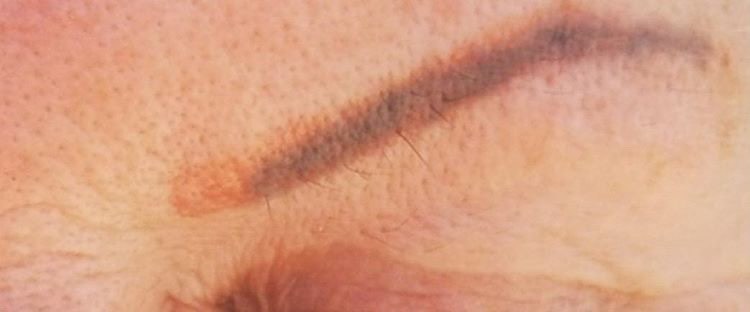A Dundee woman has spoken out about a botched beauty procedure which left her with orange eyebrows and low self-esteem.
The woman, who did not wish to be identified, has been unable to go out without makeup for the past two years after her microblading treatment went horribly wrong.
She told the Tele blood was dripping into her eyes and she “had never felt pain like it” during the procedure.
And now, she is urging young women to remain cautious when it comes to non-surgical beauty treatments.
“It has really screwed up things for me for the past two years. I can’t go out without makeup, at all, because I’ve got orange eyebrows,” she said.
She first got her eyebrows tattooed around 14 years ago, by a Perth beauty therapist. She was delighted with the outcome and colleagues at her work were so impressed they also opted for the treatment.
After four years the woman’s brows began to fade, although the basic outlines remained, so she got them topped up while on holiday in Turkey and, once again, was happy with the result.
In May 2018 she was getting a facial done by a therapist working in Dundee who suggested it was time for another top up.
After telling the beautician that she was hoping to return to Turkey, the therapist advised her that she did a process called microblading and would be happy to carry out the treatment on her.
She said: “The woman told me, ‘There are new things that have come out but I’ve got these great colours from Poland. They’re not permanent and you will need them topped up after a year and a half to two years’.
“She said that she didn’t do tattooing, but did a process called microblading.”
Microblading involves a needle which implants hundreds of tiny strokes with a medical grade pigment just under the skin, building a texture that looks like your own eyebrow hair.
“I’ve never experienced so much pain,” she said.
“The blood was dripping into my eyes and everything – I asked her to stop and she said ‘no, no it won’t be too long’.
“She never let me see what she was doing, I thought she was just going over the colour that I’d had done before.
“She took it a step further and moved them about three quarters of a centimetre in towards my nose. It wasn’t individual hair strokes, it was like a block.”
Eyebrow tattooing lasts for a lot longer than microblading, which can last for anywhere between 12 months and three years depending on the skin type.
It’s normally a two-part treatment, with an initial treatment and then a follow-up treatment around six to 12 weeks later.
The woman said: “When I saw what it looked like, I was like ‘oh my God.’ She assured me that it wouldn’t remain like that and that after 24 hours it would calm down.
“I contacted her and said, ‘mine are orange, why did you do it orange?’ She said it would change colour, to dark brown, and told me that I’d need to go back for a top up. Stupidly enough, I went.
“The process was exactly the same again, the pain, the blood, but it seemed like it split it into a complete block of colour.
“I still went to her for a couple of facials after and I kept telling her I wasn’t happy about it. She said, ‘You signed a disclosure’ and I said, ‘But you knew my hair colour is not red and it’s certainly not orange. My hair is dark, but grey at the front’.
“She said that it was just the way it had come out and that I must be on some sort of medication. I was on medication – and she knew what medication I was on – but it had never had an effect on anything I’d ever had done in the past.”
The therapist offered the woman a salt and saline tattoo removal solution which did not work, but a local tattooist advised that only laser removal would work.
Warning others against the treatment, the woman said: “I’ve been that scared that I’ve not done anything. I just feel dreadful, because you’ve got in your head that everybody is seeing orange brows, especially if you go out without makeup on. That’s what I believe people see, these orange lines around my eyebrows.
“I wouldn’t advise anybody to get it done. Microblading, especially by this person, was just awful. And I wouldn’t get them topped up ever, ever again, I would just disguise my makeup.
“As far as I’m aware she had about 10 years’ experience. But I’d never been to anyone, for anything, that’s not shown you how it’s going to look after.
“I’ll be brushing my teeth and looking in the mirror, and that’s really all I see. I think to myself, ‘why did I ever get that done?’
“It really has affected me because even with makeup on, I’m sure that people can see. I’ve had to change the actual shape of my eyebrows to cover the orange, which you can actually see through my foundation.
“Mentally, I have never been the same since having the procedure. All my family know how I feel about it. People tend to not mention it and I’ve got a couple of friends who know that I’m really, really sensitive about it.
“Stay away from any non-professionals, especially people that aren’t based in a salon and just move about from place to place. It’s just not worth it.
“It was her that suggested to me that she’d be able to do me a favour by topping them up, but it’s been far from it. I just keep wishing, every day, that they fade and get better.
“Do your homework, but also think to yourself that semi-permanent might not be semi-permanent, as in my case. I would never have anything like that done again.”
Can anyone microblade?
The path to becoming a professional microblading artist is relatively simple, but the people that perform the treatment most effectively are those who have spent time refining their skills and dedicating themselves to the craft.
One local beauty professional said: “The thing is, with microblading, there’s not really a lot of legislation in place.
“You can become a microblading artist in like two days with some courses. That’s fully accredited and everything.
“To be a microblading artist you must, firstly, be qualified. You must have an infection control certificate and you should be first aid trained.
“People can work from home, as long as the set up is right. The licensing department would come up and check your premises.
“What they would be looking for you to have is two rooms, a waiting room and a room for therapy. It should be well ventilated, have a sink with hot running water and everything should be wipeable.
“You should have a collection for people picking up all your blood-borne waste and you should know how to clean your environment properly.
“The city council will come up and check that and if they’ve OK’ed that and they’ve given you a license then that’s fine, whether it be in your house or a salon.
“When you’ve got things like Botox, you need to be registered with Health Improvement Scotland (HIS). I don’t know if they’re going to bring things like that in for microblading as well, which probably wouldn’t be a bad thing because it would stop all your backstreet people.”
Anyone who does microblading is also required to be insured.
“When you’re telling somebody what microblading is, you’ve got to tell them the truth,” she continued.
“Every client’s healed result is unique.
“Years ago, because microblading was quite a new treatment, people didn’t know that much about it so they were using the same pigment as you would use in tattooing. It’s a different method, so it needs different pigments.
“In the last two years things have improved so pigments are better and more suited for microblading. Everything is a lot better.
“But as an artist, that’s your responsibility to go and retrain yourself and pick up on all of this stuff.
“Microblading is a really, really beautiful treatment when it’s done properly but, like any treatment, it’s not suited to every single person.
“With microblading the strokes heal very thin and sometimes it’s not enough to go over a tattoo. As some people are trying to cover-up what was there before, they put the cuts far too close together and they end up with blurring and bleeding and scarring.
“It’s about being choosy with who you’re doing it for and always thinking about the healed results.”


